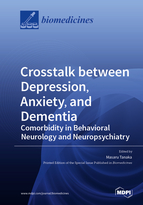Crosstalk between Depression, Anxiety, and Dementia: Comorbidity in Behavioral Neurology and Neuropsychiatry
A special issue of Biomedicines (ISSN 2227-9059). This special issue belongs to the section "Neurobiology and Clinical Neuroscience".
Deadline for manuscript submissions: closed (15 December 2020) | Viewed by 95551
Special Issue Editor
Interests: neurohormones; neuropeptides; tryptophan; kynurenine; psychiatry; neurology; depression; anxiety; dementia; cognition; antidepressant; translational research
Special Issues, Collections and Topics in MDPI journals
Special Issue Information
Dear Colleagues,
The symptoms of depression, anxiety, and dementia are a spectrum of the most common and frequently comorbid manifestations present in patients suffering from neurodegenerative and psychiatric diseases. These illnesses constitute one of the most complex and challenging research fields due to multifactorial causative factors, heterogeneous pathogenesis, and mental and behavioral manifestations. The diseases that present these symptoms range from Alzheimer’s disease, Parkinson’s disease, immunological multiple sclerosis, genetic Huntington’s disease and amyotrophic lateral sclerosis, infectious prion disease, sequelae to stroke and HIV infection, to psychiatric diseases, including depressive disorder, bipolar disorder, anxiety disorder, and autism spectrum disorder.
This Special Issue highlights the most recent research on depression, anxiety, and dementia with attention to the comorbidity in a range of diseases. We cordially invite authors to contribute original research articles focusing on, but not limited to the following:
- Etiology, pathogenesis, and progression mechanism;
- Early diagnosis including biomarker, bio-imaging, biosensors;
- Therapeutic strategies, novel targets;
- Novel drug discovery and development, naturally driven biomedicines, natural bioactive molecules, vaccines;
- Antidepressants, anti-anxiolytics, cognitive enhancers;
- Nanobiotechnology, nanosimilars, nanobiosimilars;
- Preclinical in vitro models, animal models;
- Bench-to-bedside translation research;
- Bedside-to-bench translational research.
Review articles including expert opinions, systematic analysis, metanalysis, and other statistical and analytical methods are also welcome.
Dr. Masaru Tanaka
Guest Editor
Manuscript Submission Information
Manuscripts should be submitted online at www.mdpi.com by registering and logging in to this website. Once you are registered, click here to go to the submission form. Manuscripts can be submitted until the deadline. All submissions that pass pre-check are peer-reviewed. Accepted papers will be published continuously in the journal (as soon as accepted) and will be listed together on the special issue website. Research articles, review articles as well as short communications are invited. For planned papers, a title and short abstract (about 100 words) can be sent to the Editorial Office for announcement on this website.
Submitted manuscripts should not have been published previously, nor be under consideration for publication elsewhere (except conference proceedings papers). All manuscripts are thoroughly refereed through a single-blind peer-review process. A guide for authors and other relevant information for submission of manuscripts is available on the Instructions for Authors page. Biomedicines is an international peer-reviewed open access monthly journal published by MDPI.
Please visit the Instructions for Authors page before submitting a manuscript. The Article Processing Charge (APC) for publication in this open access journal is 2600 CHF (Swiss Francs). Submitted papers should be well formatted and use good English. Authors may use MDPI's English editing service prior to publication or during author revisions.
Keywords
- depression
- anxiety
- dementia
- Alzheimer’s disease
- Parkinson’s disease
- multiple sclerosis
- Huntington’s disease
- amyotrophic lateral sclerosis
- prion disease
- HIV dementia
- stroke
- antidepressants
- anxiolytics
- nootropic agents
- neuroprotective







